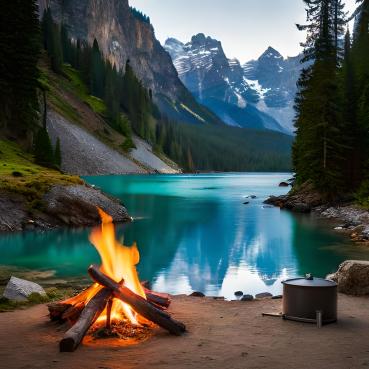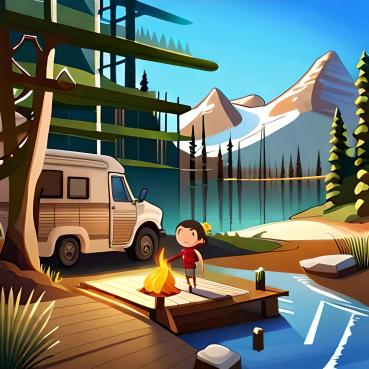
Be aware of fire regulations. In drought conditions, fires may be prohibited and you may only use a camp stove. In extreme drought conditions, even camp stoves are forbidden.
Build fires in a safe area. Open fires should be far away from your tent to prevent ignition. Never use a flame or other heating device in a tent. When camping in a Montana state park or fishing access site, fires are permitted only in designated fire rings.
Keep a shovel even a small camp shovel near the fire so it's available to use to throw dirt on the campfire. Keep a bucket of water near the fire to help extinguish it when necessary.
- Know where the nearest water faucet is located to refill the bucket after use.
- Supervise children at all times when fires are burning or grills are in use. Do not allow children to run or play around the fire ring, even when the fire is not lit.
- When near campfires, wear snug fitting clothing and be sure everyone knows how to put out a clothing fire: stop, drop, and roll.
- Thoroughly extinguish all fires.The traditional end to a camping day is a campfire

Following simple fire safety rules can prevent a smoldering ember from becoming a wildfire. Sixty-plus years after his creation by USDA Forest Service, National Association of State Foresters, and the Ad Council, Smokey [the] Bear still offers simple wildfire prevention rules:
- Dig a small pit away from overhanging branches. (Most parks have campfire pits ready and waiting for you.)
- Circle the pit with rocks or be sure it already has a metal fire ring.
- Clear a five-foot area around the pit down to the soil.
- Keep a bucket of water and a shovel nearby.
- Stack extra wood upwind and away from the fire.
- After lighting, do not discard the match until it is cold.
- Never leave a campfire unattended, not even for a minute.
- Use existing campfire rings when possible.
- Build campfires away from overhanging branches, steep slopes, rotten stumps, logs, dry grass and leaves. Pile any extra wood away from the fire.
- Keep the campfire small. A good bed of coals or a small fire surrounded by rocks gives plenty of heat. Scrape away litter, duff, and any burnable material within a 10 foot diameter circle. This will keep the campfire from spreading.
- Be sure your match is out. Hold it until it is cold.
- Never leave a campfire unattended. Even a small breeze could cause the fire to spread quickly.
- Drown the fire with water. Make sure all embers, coals, and sticks are wet. Move rocks as there may be burning embers underneath.
- Stir the remains, add more water, and stir again. If you do not have water use dirt. Do not bury your coals as they can smolder and break out.
- Consider using a small stove for cooking in remote areas vs making a campfire.
- Check local laws and ordinances prior to any burning.
- Consider alternatives to burning such as composting and recycling.
- Do not burn on windy days or when wind is expected.
- Only woody material such as leaves, grass and light brush should be burned.
- Clear all flammable material for a distance of 10 to 15 feet around the material to be burned.
- Keep piles to be burned small adding material to be burned in small quantities as burning progresses.
- Start burning as early in the day as possible. Try to finish burning before noon if possible as the morning usually has the most favorable daylight weather conditions of high humidity and low winds. These conditions will aid in keeping the fire from escaping.
- Always have a garden hose, shovel, water bucket or other means of extinguishment on hand.
- Never leave a fire unattended. Even a small breeze could quickly cause the fire to spread.
- Always be sure the fire is completely extinguished before leaving.